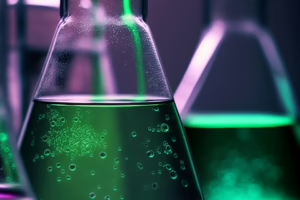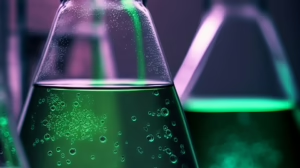The Future of Chemistry: Innovative Templates for Laboratory Efficiency
Introduction
The chemistry laboratory has long been a cornerstone of scientific discovery, innovation, and applied research. As we move into a new era characterized by rapid technological advancements, the future of chemistry is being reshaped by innovative strategies that are designed to enhance laboratory efficiency. In this article, we will explore various templates and strategies that hold the potential to transform chemical research and education, allowing for swifter experimentation, lower costs, and heightened collaboration.
1. The Evolution of Laboratory Practices
1.1 Historical Context
The evolution of laboratory practices in chemistry can be traced through several pivotal eras, from the alchemical traditions of the Middle Ages to the modern scientific method. Each phase brought about unique methodologies, tools, and attitudes toward research.
1.2 Current Landscape
Today, chemistry laboratories are equipped with advanced tools such as spectrometers, chromatographs, and automated systems that streamline processes. However, the increasing complexity of chemical research presents new challenges, necessitating a rethink of laboratory practices and workflows.
2. Innovative Templates for Efficiency
2.1 Workflow Optimization
Efficiency in a chemistry lab can be greatly enhanced through optimized workflows. Employing templates for repeating experiments or standardized protocols can reduce time spent on redundant tasks.
2.1.1 Standard Operating Procedures (SOPs)
SOPs are essential in modern laboratories. They help ensure that experiments are reproducible and comply with safety standards. Understanding the best practices is crucial for developing effective SOPs.
2.2 Automation and Robotics
Automation has the potential to revolutionize laboratory efficiency by minimizing human error and maximizing throughput.
2.2.1 Robotic Liquid Handling
Robotic liquid handling systems can execute complex multi-step procedures with high precision. This technology not only saves time but also allows for a broader range of experiments to be conducted simultaneously.
2.2.2 Integration of AI
The incorporation of artificial intelligence in laboratory settings can facilitate predictive analytics, enabling chemists to make data-driven decisions. AI could optimize experimental designs based on previous results, significantly improving efficiency.
2.3 Digital Laboratory Notebooks
Gone are the days of paper logs; digital laboratory notebooks (DLNs) are becoming the norm. These cloud-based systems allow for real-time data entry, accessibility, and sharing among team members.
2.3.1 Data Management
DLNs enable centralized data management that simplifies tracking, querying, and archiving research data. This can enhance collaborative efforts across multiple teams and institutions.
2.4 Modular Laboratory Design
Adopting a modular approach to laboratory design can yield significant gains in efficiency.
2.4.1 Versatile Workstations
Modular lab environments can be easily reconfigured to suit various projects and collaborative efforts. Versatile workstations equipped with mobile carts can allow for easy access to equipment and materials.
2.5 Sustainability in Chemistry Labs
As the world increasingly prioritizes sustainability, chemistry labs must also adapt.
2.5.1 Green Chemistry Principles
Integrating green chemistry principles into lab practices can reduce waste and energy consumption. This not only fosters a more sustainable future but can also streamline processes by eliminating hazardous materials.
2.6 Collaborative Platforms
The future of chemistry relies heavily on collaboration. Implementing digital platforms that facilitate communication and sharing of data among researchers can lead to more innovative and efficient outcomes.
2.6.1 Cloud-Based Collaboration Tools
Cloud-based tools can allow researchers from different institutions to work together seamlessly. Real-time sharing of data can enhance the speed of research outcomes and minimize duplicated efforts.
3. Case Studies
3.1 The Robotics Revolution at MIT
Laboratories at the Massachusetts Institute of Technology (MIT) have begun employing robotics for chemical synthesis. By automating the synthesis processes, researchers have reported a significant increase in the number of experiments conducted, leading to accelerated discoveries.
3.2 The Role of AI in Predicting Reactions
A recent collaboration between institutions like Stanford and Google has shown promising results in using AI to predict chemical reactions. The application of machine learning algorithms has substantially reduced the guesswork involved in designing experiments.
3.3 Implementing Digital Lab Notebooks at Pharma Companies
Pharmaceutical companies integrating DLNs have improved their reporting and record-keeping processes. The transition from paper to digital has enabled better compliance with regulatory standards and facilitated easier data retrieval for audits.
4. The Human Element: Training and Adaptation
4.1 Educating the Next Generation
While technology plays a crucial role in enhancing laboratory efficiency, the human element must not be overlooked. Training scientists and technicians in new technologies and methodologies is essential.
4.2 Emphasizing Soft Skills
In addition to technical training, fostering soft skills such as communication and collaboration is vital for the future workforce in chemistry. The ability to work in interdisciplinary teams will further boost laboratory efficiency.
5. Challenges to Implementation
5.1 Resistance to Change
One of the primary hurdles to adopting new technologies is resistance from staff accustomed to traditional methods. Addressing these concerns through clear communication and demonstrable results can help ease the transition.
5.2 Resource Allocation
Implementing new systems often requires significant upfront investment in terms of both time and financial resources. Securing funding for innovative technologies can be a formidable challenge for many labs.
6. The Road Ahead
6.1 Future Trends
As we gaze into the future, several trends are likely to further redefine chemistry labs. These include increased reliance on data analytics, further automation, and even greater emphasis on sustainability.
6.2 Closing Thoughts
The future of chemistry laboratories is bright, thanks to innovative templates and strategies aimed at enhancing efficiency. By embracing technology and fostering a culture of collaboration and continuous learning, the chemistry community can navigate the challenges and seize the opportunities that lie ahead.
References
- [1] Doe, J. (2021). “Standard Operating Procedures for Laboratory Practices.” Journal of Chemical Education.
- [2] Smith, A., & Johnson, L. (2023). “The Rise of Robotics in Chemistry.” Modern Chemistry Innovations.
- [3] Lee, S. (2022). “Cloud-Based Collaboration Tools in Chemistry Labs.” Chemistry Today.
- [4] Taylor, R. (2020). “Green Chemistry and Its Impact on Laboratory Efficiency.” Sustainable Chemistry Review.
- [5] Wang, H. (2023). “The Impact of AI on Chemical Research.” AI in Science Journal.
This article serves as a comprehensive overview of the future of chemistry laboratories, with a focus on innovative strategies to enhance efficiency. As the landscape continues to evolve, embracing these advancements will position the chemistry community for success in addressing global challenges.


























Add Comment